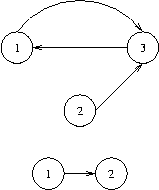POJ2553——The Bottom of a Graph
来源:互联网 发布:笔顺查询软件下载 编辑:程序博客网 时间:2024/06/05 21:03
The Bottom of a Graph
Time Limit: 3000MS Memory Limit: 65536KTotal Submissions: 8902 Accepted: 3688
Description
We will use the following (standard) definitions from graph theory. LetV be a nonempty and finite set, its elements being called vertices (or nodes). LetE be a subset of the Cartesian product V×V, its elements being called edges. ThenG=(V,E) is called a directed graph.
Let n be a positive integer, and let p=(e1,...,en) be a sequence of lengthn of edges ei∈E such that ei=(vi,vi+1) for a sequence of vertices(v1,...,vn+1). Then p is called a path from vertexv1 to vertex vn+1 in G and we say thatvn+1 is reachable from v1, writing (v1→vn+1).
Here are some new definitions. A node v in a graph G=(V,E) is called a sink, if for every nodew in G that is reachable from v, v is also reachable fromw. The bottom of a graph is the subset of all nodes that are sinks, i.e.,bottom(G)={v∈V|∀w∈V:(v→w)⇒(w→v)}. You have to calculate the bottom of certain graphs.
Let n be a positive integer, and let p=(e1,...,en) be a sequence of lengthn of edges ei∈E such that ei=(vi,vi+1) for a sequence of vertices(v1,...,vn+1). Then p is called a path from vertexv1 to vertex vn+1 in G and we say thatvn+1 is reachable from v1, writing (v1→vn+1).
Here are some new definitions. A node v in a graph G=(V,E) is called a sink, if for every nodew in G that is reachable from v, v is also reachable fromw. The bottom of a graph is the subset of all nodes that are sinks, i.e.,bottom(G)={v∈V|∀w∈V:(v→w)⇒(w→v)}. You have to calculate the bottom of certain graphs.
Input
The input contains several test cases, each of which corresponds to a directed graphG. Each test case starts with an integer number v, denoting the number of vertices ofG=(V,E), where the vertices will be identified by the integer numbers in the setV={1,...,v}. You may assume that 1<=v<=5000. That is followed by a non-negative integere and, thereafter, e pairs of vertex identifiers v1,w1,...,ve,we with the meaning that(vi,wi)∈E. There are no edges other than specified by these pairs. The last test case is followed by a zero.
Output
For each test case output the bottom of the specified graph on a single line. To this end, print the numbers of all nodes that are sinks in sorted order separated by a single space character. If the bottom is empty, print an empty line. 

Sample Input
3 31 3 2 3 3 12 11 20
Sample Output
1 32
Source
Ulm Local 2003
看图就能理解,其实就是找缩点后,出度为0的点,所以就是tarjan+缩点了
看图就能理解,其实就是找缩点后,出度为0的点,所以就是tarjan+缩点了
#include<map>#include<set>#include<list>#include<stack>#include<queue>#include<vector>#include<cmath>#include<cstdio>#include<cstring>#include<iostream>#include<algorithm>using namespace std;const int N = 100010;const int M = 200010;const int inf = 0x3f3f3f3f;int DFN[N];int low[N];int block[N];int Stack[N];int out[N];bool instack[N];int head[N];int ans[N];int tot, sccnum, index, top, n, m;struct node{ int next; int to;}edge[M];void addedge(int from, int to){ edge[tot].to = to; edge[tot].next = head[from]; head[from] = tot++;}void init(){ memset( instack, 0, sizeof(instack) ); memset( DFN, 0, sizeof(DFN) ); memset( low, 0, sizeof(low) ); memset( out, 0, sizeof(out) ); sccnum = index = top = 0;}void tarjan(int u){ DFN[u] = low[u] = ++index; Stack[top++] = u; instack[u] = 1; for (int i = head[u]; i != -1; i = edge[i].next) { int v = edge[i].to; if (DFN[v] == 0) { tarjan(v); if (low[u] > low[v]) { low[u] = low[v]; } } else if (instack[v]) { if (low[u] > DFN[v]) { low[u] = DFN[v]; } } } if (DFN[u] == low[u]) { sccnum++; do { top--; block[Stack[top]] = sccnum; instack[Stack[top]] = 0; }while (Stack[top] != u); }}void solve(){ init(); for (int i = 1; i <= n; i++) { if (DFN[i] == 0) { tarjan(i); } } for (int i = 1; i <= n; i++) { for (int j = head[i]; j != -1; j = edge[j].next) { if (block[i] != block[edge[j].to]) { out[block[i]]++; } } } int cnt = 0; for (int i = 1; i <= n; i++) { if (out[block[i]] == 0) { ans[cnt++] = i; } } sort(ans, ans + cnt); printf("%d", ans[0]); for (int i = 1; i < cnt; i++) { printf(" %d", ans[i]); } printf("\n");}int main(){ while (~scanf("%d", &n), n) { scanf("%d", &m); memset( head, -1, sizeof(head) ); tot = 0; int u, v; for (int i = 0; i < m; i++) { scanf("%d%d", &u, &v); addedge(u, v); } solve(); } return 0;} 0 0
- poj2553——The Bottom of a Graph
- POJ2553——The Bottom of a Graph
- poj2553 The Bottom of a Graph
- poj2553 - The Bottom of a Graph
- POJ2553 The Bottom of a Graph
- POJ2553 The Bottom of a Graph (Tarjan)
- POJ2553-The Bottom of a Graph
- poj2553 The Bottom of a Graph
- poj2553 The Bottom of a Graph (Tarjan)
- POJ2553————The Bottom of a Graph(tarjan算法)
- poj2553——The Bottom of a Graph(强连通分量)
- SCC::poj2186 Popupar Cows && poj2553 The Bottom of A Graph
- ZOJ1979 POJ2553 The Bottom of a Graph,经典Tarjan
- POJ2553 The Bottom of a Graph 强连通 tarjan
- POJ2553:The Bottom of a Graph(tarjan缩点)
- poj2553-The Bottom of a Graph(强连通分量)
- The Bottom of a Graph-POJ2553强连通
- poj2553 The Bottom of a Graph【强连通】
- 在Android上使用ZXing识别条码/二维码
- UrlRouting的理解
- 内存的堆分配和栈分配 & 字符数组,字符指针,Sizeof总结
- C语言四书五经
- android https 连接建立
- POJ2553——The Bottom of a Graph
- 如何从android官网下载开发工具
- C - Hyperhuffman(哈弗曼值)
- 避免Android开发中的ANR
- Myeclipse快捷操作
- 【Ardunio】开发入门教程【二】数据类型
- 人生感悟:人生像吃自助餐
- 怎样花两年时间去面试一个人
- 开发入门教程【三】Arduino开发工具


